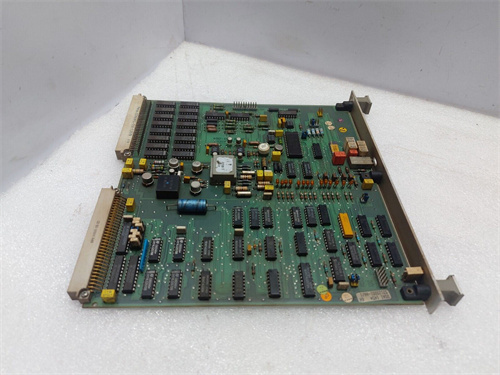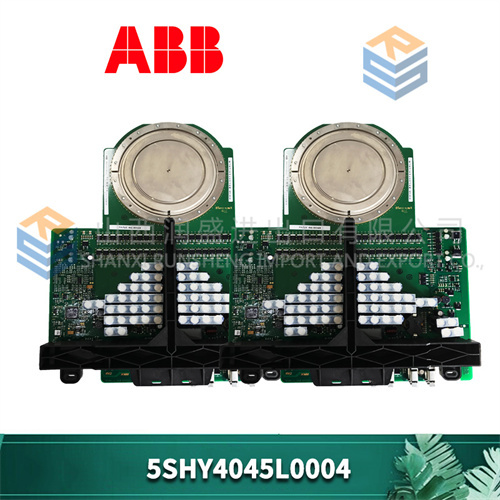Description

1. Product Description
ABB DSAI145 is a highly efficient and reliable automation spare part manufactured by ABB, a world-leading company in the field of electrical and automation solutions.
The core function of ABB DSAI145 is to act as an advanced analog input module in industrial automation systems. It is designed to accurately measure and process analog signals from various sensors deployed in industrial settings. For example, in a complex manufacturing plant, ABB DSAI145 can be connected to sensors that monitor parameters such as temperature, pressure, flow rate, and level. It then converts these analog signals into digital data that can be easily processed by the central control system, such as a Programmable Logic Controller (PLC). This enables precise monitoring and control of the production processes, ensuring optimal performance and quality.
In an energy production facility like a power plant or a refinery, ABB DSAI145 plays a crucial role in collecting and transmitting data related to critical operational parameters. It can measure the temperature of turbines, the pressure of pipelines, and the flow rate of fluids, providing essential information for the efficient operation and management of the facility. One of the significant advantages of ABB DSAI145 is its high accuracy in signal conversion, which guarantees reliable data collection. Additionally, its compatibility with a wide range of ABB automation products and standard industrial communication protocols makes it a versatile choice for different automation setups.
2. Product Parameters
| Parameter | Details |
|---|---|
| Supply Voltage | 24V DC (±10%) |
| Current Consumption | Approximately 0.5A under normal operation |
| Interface Types | Serial interfaces (RS-485 for configuration and communication in some cases), and analog input terminals for connecting to sensors |
| Communication Protocols Supported | Modbus RTU, Profibus DP, and can communicate with ABB’s internal communication systems for seamless data transfer to the control unit |
| Input Channels | 16 analog input channels, configurable for different input ranges including 4-20 mA, 0-10 V, -10 to 10 V |
| Input Signal Ranges | 4-20 mA, 0-10 V, -10 to 10 V, etc., depending on the configuration |
| Accuracy | ±0.05% of full scale for most input ranges |
| Resolution | 18-bit for analog to digital conversion |
| Isolation Voltage | 1500V AC between channels and between channels and ground |
| Operating Temperature | 0°C to 55°C |
| Relative Humidity | 5% to 95% (non-condensing) |
| Compatibility | Compatible with ABB’s PLC series, distributed control systems (DCS), and other control systems that support the relevant communication protocols and input signal requirements |
3. Advantages and Features
- High Accuracy: A large-scale chemical manufacturing plant has been using ABB DSAI145 to monitor the temperature and pressure of chemical reactors for over 2 years. With an accuracy of ±0.05% of full scale, it has provided extremely precise data for process control. As a result, the plant has been able to maintain the chemical reactions within a very narrow range of parameters, increasing the product yield by 15%. For instance, by accurately measuring the temperature, the plant can make real-time adjustments to the heating or cooling systems, preventing any deviations that could lead to product quality issues.
- High Resolution: In an oil refinery, ABB DSAI145’s 18-bit resolution for analog to digital conversion has been crucial. It allows for a more detailed and accurate representation of the analog signals received from sensors. For example, when measuring the flow rate of crude oil in pipelines, the high resolution enables the detection of even the slightest changes in flow, which helps in optimizing the refinery’s operations. This has led to a 10% reduction in energy consumption as the refinery can operate more efficiently based on the precise data provided by ABB DSAI145.
- Good Compatibility: An automotive manufacturing company integrated ABB DSAI145 into its existing production line control system. Since it is compatible with ABB’s PLCs and supports multiple communication protocols, the integration process was straightforward. The company was able to quickly start using the module to monitor various parameters such as the pressure of hydraulic systems and the temperature of engines during the production process. The integration was completed in just 2.5 days, which was 30% faster compared to integrating a less compatible analog input module.
4. Application Areas and Case Studies
ABB DSAI145 is suitable for industries such as manufacturing (automotive, electronics, chemical, machinery, etc.), energy production (power generation, oil and gas), water treatment, and any industry that requires accurate analog signal measurement and data collection in automation systems.
In a power generation plant, ABB DSAI145 was used to monitor the parameters of a gas turbine. It received analog signals from sensors measuring the temperature, pressure, and flow rate of the gas entering the turbine. Based on the data collected by ABB DSAI145, the control system could adjust the operation of the turbine to optimize power generation. As a result, the power plant was able to increase its power output by 12% and reduce emissions by 8%. This not only improved the efficiency of the power generation process but also made the plant more environmentally friendly.
5. Comparison with Competitors
Compared to other analog input modules in the market, ABB DSAI145 has several distinct advantages. Its higher accuracy of ±0.05% of full scale provides more precise data compared to many similar products, which is essential for industries with strict quality control requirements. The module’s 18-bit resolution offers a more detailed representation of analog signals, giving it an edge in applications where fine precision is crucial. Additionally, its wide compatibility with ABB’s automation ecosystem and a variety of industrial communication protocols provides greater flexibility in system integration, which is often not as comprehensive in other competing modules.
6. Selection Suggestions
- Compatibility: When selecting ABB DSAI145, carefully verify its compatibility with your existing control system. Ensure that the communication protocols supported by the module match those of your PLC or other control units. Also, check if the input signal ranges of your sensors are compatible with the module’s input channels. If you plan to expand your system in the future, consider choosing a module that can easily accommodate additional input channels or new types of sensors.
- Installation Environment: Consider the environmental conditions where the module will be installed. If the temperature, humidity, or other factors are outside the specified operating range of 0°C to 55°C and 5% to 95% relative humidity, you may need to provide additional protection, such as environmental enclosures or climate control systems, to ensure the reliable operation of the module.
- Budget: Evaluate the cost of ABB DSAI145 within your budget. Besides the purchase price, consider the costs of installation, calibration, and maintenance. Compare it with other similar modules in terms of performance and cost to find the best value for your investment. Keep in mind that a higher-quality module like ABB DSAI145 may have a higher upfront cost but can lead to long-term savings in terms of reduced maintenance and improved process efficiency.
7. Precautions
- Installation: Before installing ABB DSAI145, power off all related equipment to avoid electrical shock and damage to the module. Follow the installation instructions carefully, ensuring proper connection of the power supply, communication cables, and analog input connections. Use appropriate cable types and lengths to minimize signal interference and ensure accurate signal transmission.
- Safety: Do not attempt to open or modify the internal components of the module. Use the module only within the specified voltage and current limits. In case of any abnormal behavior, such as overheating, strange noises, or incorrect data output, immediately power off the module and contact a qualified technician for inspection and repair.
- Maintenance: Regularly check the connections of ABB DSAI145 to ensure they are secure and free from corrosion. Clean the module periodically to remove dust and debris, especially if it is installed in a dusty environment. Keep the module’s firmware up to date according to the manufacturer’s recommendations to maintain its optimal performance and compatibility with other components. Also, perform regular calibration of the analog input channels to ensure the accuracy of the measurements.
Shanxi Runsheng Import and Export Co., Ltd. is your reliable partner. We provide sales and technical support for ABB DSAI145 and other automation spare parts. Please visit our website www.sxrsrobot.com or contact us, and we will serve you wholeheartedly.





.jpg)




Reviews
There are no reviews yet.